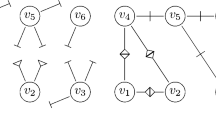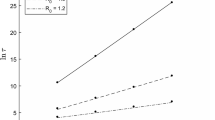Abstract
We consider epidemics on social networks and address the question of whether administering a safe vaccine to one or more individuals can raise another individual’s chances of becoming infected. Surprisingly, this can happen if transmission probabilities vary over time. If transmission probabilities do not vary with time, we show that in the discrete SIR model vaccination cannot cause collateral damage. We phrase this question in terms of monotonicity properties and answer it using bond percolation methods. By passing to a covering graph we are able to extend these results to models with more complicated latent and infective states.
Similar content being viewed by others
References
Anderson, R.M., 1991. Discussion: the Kermack–McKendrick epidemic threshold theorem. Bull. Math. Biol. 53, 3–32.
Colizza, V., Barrat, A., Barthelemy, M., Valleron, A.-J., Vespignani, A., 2007. Modeling the Worldwide spread of pandemic influenza: baseline case and containment interventions. PLoS Medecine 4.
Dezsö, Z., Barabási, A.-L., 2002. Halting viruses in scale-free networks. Phys. Rev. E 65, 055103(R).
Eubank, S., Anil Kumar, V.S., Marathe, M.V., Srinivasan, A., Wang, N., 2006. Structure of social contact networks and their impact on epidemics. In: Abello, J., Cormode, G. (Eds.), Discrete Methods in Epidemiology. DIMACS Series in Discrete Mathematics and Theoretical Computer Science, vol. 70, pp. 179–185.
Ferrari, M.J., Bansal, S., Meyers, L.A., Björnstad, O.N., 2006. Network frailty and the geometry of herd immunity. Proc. Roy. Soc. B 273, 2743–2748.
Grassberger, P., 1983. Critical behavior of the general epidemic process and dynamical percolation. Math. Biosci. 63, 157–172.
Hartvigsen, G., Dresch, J.M., Zielinski, A.L., Macula, A.J., Leary, C.C., 2007. Network structure, and vaccination strategy and effort interact to affect the dynamics of influenza epidemics. J. Theor. Biol. 246, 205–213.
Kermack, W.O., McKendrick, A.G., 1927. A contribution to the mathematical theory of epidemics. Proc. Roy. Soc. Lond. A 115, 700–721.
Meyers, L.A., 2007. Contact network epidemiology: bond percolation applied to infectious disease prediction and control. Bull. Am. Math. Soc. 44, 63–86.
Newman, M.E.J., 2002. Spread of epidemic disease on networks. Phys. Rev. E 66, 016128.
Sander, L.M., Warren, C.P., Sokolov, I.M., Simon, C., Koopman, J., 2002. Percolation on heterogeneous networks as a model for epidemics. Math. Biosci. 180, 293–205.
Author information
Authors and Affiliations
Corresponding author
Rights and permissions
About this article
Cite this article
Floyd, W., Kay, L. & Shapiro, M. Some Elementary Properties of SIR Networks or, Can I Get Sick because You Got Vaccinated?. Bull. Math. Biol. 70, 713–727 (2008). https://doi.org/10.1007/s11538-007-9275-0
Received:
Accepted:
Published:
Issue Date:
DOI: https://doi.org/10.1007/s11538-007-9275-0




